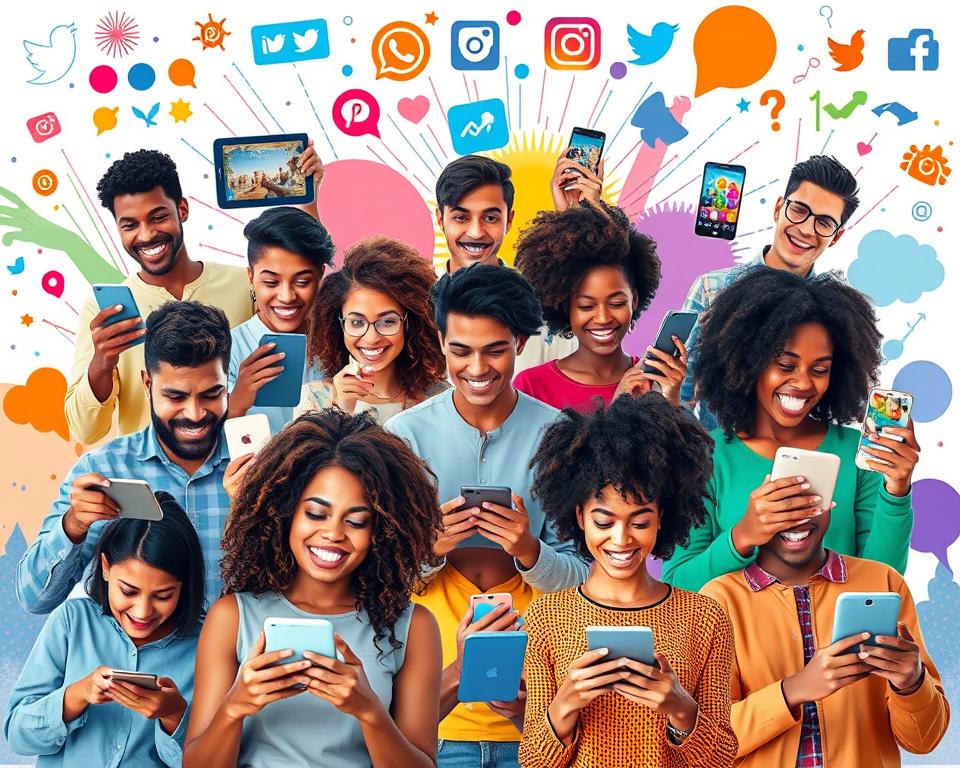A whopping 92% of consumers love brands that share stories. This shows how important brand storytelling trends 2025 are. They help grab people’s attention. As we look ahead, new ways to tell stories will be key for brands to reach their audience.
We’ll dive into the top brand storytelling trends for 2025. You’ll learn how brands can use stories to hit their marketing targets. This will shape the future of brand storytelling.
Key Takeaways.
- Brand storytelling trends 2025 will play a key role in grabbing people’s attention.
- New storytelling methods will be vital for brands to connect with their audience.
- The future of brand storytelling will be shaped by tech and digital media.
- Using stories well can help brands meet their marketing goals.
- Brand storytelling trends 2025 will focus on immersive and interactive experiences.
- The rise of digital media will keep influencing brand storytelling trends 2025.
- Understanding the future of brand storytelling is key for brands to stay competitive.
The Evolution of Brand Storytelling Trends 2025.
Digital transformation has changed marketing trends a lot. Social media has made brands move from old to new storytelling ways. Now, they focus on making experiences that grab your attention. Companies like Nike and Coca-Cola are leading the way with their creative stories.
Authenticity and personal content are key now. Storytelling techniques are getting more interactive, like with virtual and augmented reality. This change is because of how people act differently and how brands need to stand out.
- More use of social media for sharing stories.
- Authenticity and transparency becoming more important.
- Data and analytics for making content that hits the mark.
Digital storytelling will be essential for brand communication’s future. By using new tech and creative ways, brands can make stories that really connect with people.
Immersive Storytelling Through Extended Reality.
We’re seeing a big change in how brands talk to their audience. Innovative storytelling is leading this change. Extended reality (XR) like virtual and augmented reality offers deep, interactive stories. These stories can make a brand more relatable, raise awareness, and get people involved.
XR is great for visual storytelling because it’s both fun and memorable. For instance, a brand can let customers dive into a virtual world to see a product up close. This can make customers understand and want to buy more.
Here are some ways XR is used in storytelling for brands:
- Virtual product demos.
- Immersive brand experiences.
- Interactive stories.
As XR gets better, we’ll see even more creative uses in marketing. Brands that use XR will offer unique, engaging experiences. These experiences will help them stand out from others.
AI-Powered Narrative Personalization.
We’re seeing a big change in how brands make their content. Now, they focus more on making content that speaks directly to their audience. This is thanks to AI, which helps create stories that really connect with people. By using machine learning, brands can make content that fits what their audience likes.
Some big pluses of using AI for personalizing stories include:
- More people engage with content that feels made just for them.
- Brands keep more customers because they feel understood.
- Creating and sharing content gets a lot easier and faster.
Looking into how AI changes storytelling, it’s clear it’s a game-changer. Brands that use AI to personalize their stories can make a bigger impact. They can tell stories that not only grab attention but also lead to real results.
The secret to great AI-powered storytelling is finding the right mix. It’s about using AI’s power and adding the touch of human emotion. This way, brands can craft stories that truly resonate and make a lasting impression.
User-Generated Content Integration

Exploring the latest marketing trends shows how important user-generated content (UGC) is. It helps brands connect with their audience’s creativity and enthusiasm. This boosts brand awareness and trust.
Some benefits of UGC integration include:
- Increased brand awareness and reach.
- Improved customer engagement and loyalty.
- Enhanced credibility and trust.
Brands like Coca-Cola and Nike have made UGC a key part of their marketing. They use social media and influencer partnerships to get customers to share their stories.
By using UGC, brands can tell more genuine and engaging stories. This drives customer loyalty and engagement. Looking ahead to brand storytelling trends 2025, UGC’s role is key.
UGC is a powerful tool for brands, allowing them to tap into the creativity and enthusiasm of their audience and create a more authentic and engaging narrative.
As we dive into the latest marketing trends, UGC’s importance in brand storytelling will only grow.
Voice-First Storytelling Approaches.
Exploring the future of brand storytelling, we see the rise of voice-first methods. Smart speakers and voice assistants are changing how we interact with brands. Brands now aim to create engaging voice-first experiences that connect with their audience.
Storytelling techniques, like conversational marketing and audio branding, are key. For instance, a brand might use a smart speaker to share a story about its products. This approach makes users feel like they’re talking to a real person.
Important aspects of voice-first storytelling include:
- Smart speaker optimization for a smooth user experience.
- Audio branding elements, like sound effects and music, for an immersive feel.
- Conversational marketing integration to keep users engaged.
By using these elements, brands can craft compelling voice-first stories. These stories are not just engaging but also shape the future of brand storytelling.
Sustainable and Purpose-Driven Narratives

We know how important it is to use sustainable and purpose-driven stories in our brand. These stories match what our audience values. By telling new and engaging stories, we can get more people to know about our brand. This helps build trust and keeps customers interested.
These stories help us connect with our customers on a deeper level. It creates a sense of community and shared goals.
Some key parts of these stories include:
- Social responsibility initiatives, showing we care about giving back.
- Environmental campaigns, showing our efforts to be kind to the planet.
- Diversity and inclusion programs, promoting equality and respect for everyone.
By adding these elements to our brand story, we create a story that truly speaks to our audience. Innovative storytelling is key here. It lets us share our message in a way that grabs attention. As we grow, we promise to keep adding these important parts to our story. This will make our brand even stronger and more connected to our customers.
We’re committed to making a positive difference in our community and the environment. At the same time, we want to grow our business. By following this path, we aim to leave a lasting mark. We want to be seen as leaders in both innovative storytelling and doing good for society.
Multi-Platform Story Architecture.
Exploring brand storytelling, we find the need for a multi-platform story architecture. This method helps brands share consistent and engaging stories across different channels. It boosts their content strategy and digital storytelling. By using marketing trends, brands can connect with their audience better.
Key elements of multi-platform story architecture include:
- Cross-channel content synchronization: making sure all channels share the same story.
- Platform-specific story adaptation: adjusting the story for each platform’s unique audience.
- Unified brand message management: keeping the same tone and message everywhere.
Using a multi-platform story architecture brings many benefits. Brands see more engagement, better consistency, and improved customer experiences. As we look at marketing trends, a solid content strategy is key for success online.
Some brands have seen great success with this approach. By studying these examples and using the latest marketing trends, brands can craft compelling stories. These stories engage their audience and help drive business results.
| Brand | Multi-Platform Story Architecture | Results |
|---|---|---|
| Brand A | Cross-channel content synchronization and platform-specific story adaptation | 25% increase in engagement and 15% increase in sales |
| Brand B | Unified brand message management and tailored narrative for each platform | 30% increase in brand consistency and 20% increase in customer loyalty |
Conclusion: Embracing the Future of Brand Communication.
The world of brand storytelling is about to change a lot. Brands need to keep up with new trends and tech to stay ahead. This is key for 2025 and beyond.
Immersive experiences and AI will make stories more personal and powerful. Brands can connect better with people by using content from users and voice platforms. This way, they can build stronger bonds with their audience.
Brands that focus on stories that matter will win. They should tell stories that reflect what people value and dream about. This way, they can share a clear message that excites and motivates everyone.
The future of brand storytelling is all about being innovative and real. It’s about creating experiences that truly matter to people. By doing this, brands can stay on top in the changing world of communication.


0 Comments